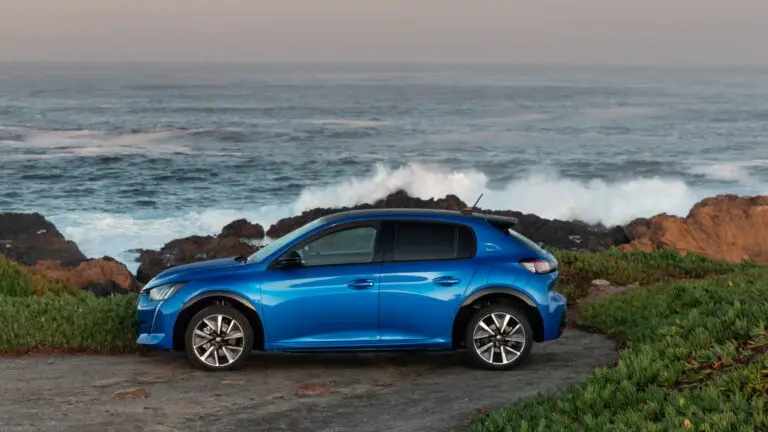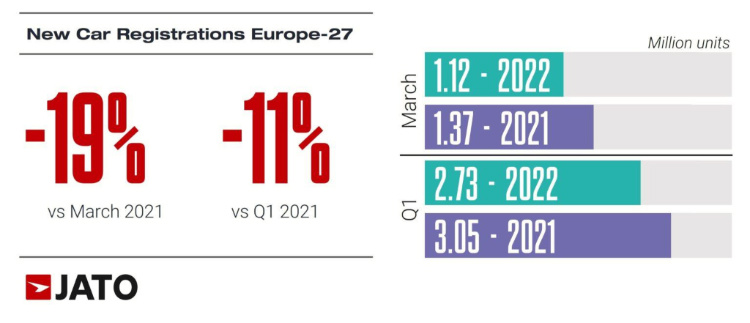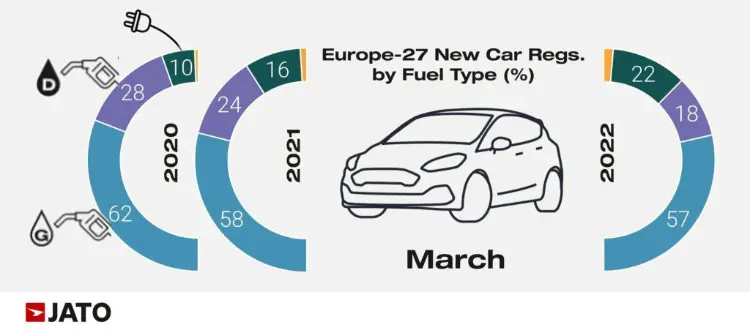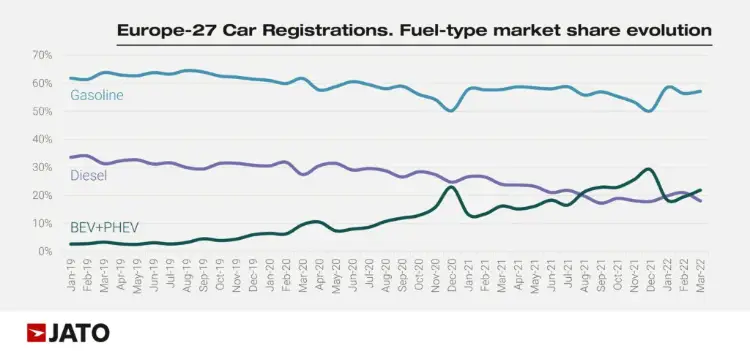In March 2022, the European new car market was 20% weaker with electric vehicles gaining market share and the Tesla Model 3 the top-selling car in Europe.

New passenger vehicle registrations in Europe contracted by a fifth in March 2022 with new car sales down 11% during the first quarter of 2022 to the lowest levels seen since 1985. Electrified cars continued to gain market share and again outsold diesel vehicles in Europe in March 2022. The Tesla Model 3 was the top-selling car model and the best-selling battery-electric vehicle in Europe in March 2022 but the Peugeot 208 was Europe’s favorite car during the first quarter of the year.
Latest European Car Market Statistics 2022: By Country, Brands, Models, Electric, January, February, March, April, May, June, July, August, September, October, November, Full Year, 2021 & 2020
New Car Market in Europe in 2022 (March)

According to JATO Dynamics data for 27 European markets, total new passenger vehicle registrations in Europe (including the EU, EFTA, and UK) were down by 19% when compared to March 2021, with 1,116,419 new passenger cars registered. While registrations increased by 33% compared to March 2020, the market is yet to see a return to pre-pandemic levels, falling short of March 2019 by 37%.
Due to ongoing uncertainty around the availability of new cars and the impact of the invasion in Ukraine, consumers in Europe are not buying cars at the levels seen previously. Felipe Munoz, Global Analyst at JATO Dynamics, commented: “Although Ukraine is not a large market for European car exports, with a small market relative to its population, it remains to be an important source of vehicle parts for major European OEMs”. Last year, the Ukrainian new car market totaled 103,300 units, making it the 20th largest in Europe, including Russia.
However, it should be noted that supply is as big a problem as demand. Many manufacturers have full order books but are unable to produce cars due to a shortage in components. This is particularly evident in countries such as Germany where consumers generally order cars with personalized specifications from the factory rather than buy vehicles from already produced stock.
In 2022 (Q1), European new car sales were worse than those seen two years ago when Europe was first hit by the pandemic, as volume decreased by 10% during the first three months of the year to 2.73 million units – the lowest level since 1985.
New Car Sales in Europe by Fuel Type in March 2022

In March 2022, the popularity of low emissions vehicles continued to increase while diesels are increasingly losing market share in Europe. Plug-in hybrid and pure electric cars (PHEV and BEV) outperformed diesels with 244,801 new registrations, compared to the 202,113 units for the latter. For BEVs and PHEVs, this equates to a volume increase of 10%, while for diesels, volume fell by 39%.

Munoz added: “We continue to see more and more new EVs enter the market. And with the support of good deals, incentives, and shorter waiting times compared with ICE vehicles, it’s become easier for consumers to jump on the EV boom.” The shift in favor of low emissions vehicles was particularly prevalent in countries such as Switzerland (which had a 28% EV market share vs 14% diesel market share), the UK (23% vs 10%), France (21% vs 16%) and Belgium (24% vs 19%), in addition to the well-established trends seen in Norway, Sweden, Netherlands, and Denmark.
BEVs accounted for almost 62% of all low emissions vehicle registrations in March, with a volume increase of 46%. In contrast, plug-in hybrids posted a 22% decline during the month with 93,100 units registered. Munoz continued: “Because these vehicles rely on an ICE powertrain, PHEVs don’t benefit from the government incentives granted to BEVs. At the same time, developing and manufacturing batteries is a costly process, therefore without incentives, these already expensive vehicles are understandably less appealing to consumers.”
PHEV sales are likely to be particularly hard hit in Germany where government subsidies are ending at the end of 2022 while many manufacturers are unable to guarantee that ordered cars will be delivered before 2023.
Best-Selling Car Models in Europe in March 2022

In March 2022, the Tesla Model 3 was Europe’s best-selling new car model with 23,013 new registrations, down by 3% compared to the 23,758 units registered in March 2021. This drop was relatively insignificant compared to those recorded by the models of other big players including the Peugeot 208 (-17%), Volkswagen Golf (-36%), Toyota Yaris (-31%), and Opel Corsa (-36%).
The negative growth posted by the Model 3 is partly explained by the increasing popularity of the Model Y, its SUV twin. This midsize SUV secured a record third position in the overall ranking. Thanks to these two models, last month Tesla was able to outsell mainstream brands like Dacia, Citroen, Fiat, and Nissan. For Q1 2022, Tesla took 18th position in the ranking by brand, closing the gap on Seat and moving ahead of Nissan. The US manufacturer was also among the top 10 most registered brands in 9 European countries.
As before, Tesla deliveries were high in the final month of the quarter. Year-to-date 2022, the top-selling car models in Europe were the Peugeot 208, Dacia Sandero, and Volkswagen Golf with the Tesla Model 3 not even in the top ten.
The latest generation of the Dacia Sandero continued to be a favourite among European consumers, while Kia saw strong results after introducing the all-new Sportage. Toyota registered almost 11,400 units of the Yaris Cross, becoming the 6th best-selling B-SUV in Europe. The Opel/Vauxhall Mokka followed closely, doubling its volume compared with March 2021.
Cupra continued to gain market share thanks to the Formentor, Europe’s 4th most popular PHEV during the month. The Renault Arkana was the third most registered model in the Renault lineup, behind the Captur and Clio, while the Kia Xceed saw a volume increase of 56%. Volkswagen registered more than 5,500 units of the Taigo, and MG almost doubled registrations of the ZS to almost 5,400 units; the MG HS was up by 188% to 4,229 units. Thanks to its latest generation, the BMW 4-Series increased registrations by 72% to 5,181 units.
Among the fully electric models, the Fiat 500 took third place in the BEV ranking, making up 41% of the model’s total volume. Dacia registered almost 4,000 units of the Spring, 53% of which were in France. Hyundai and Kia registered 3,243 and 2,941 units of the IONIQ 5 and EV6, respectively. The Polestar 2’s volume jumped from 1,343 units in March 2021 to 3,003 units last month.
